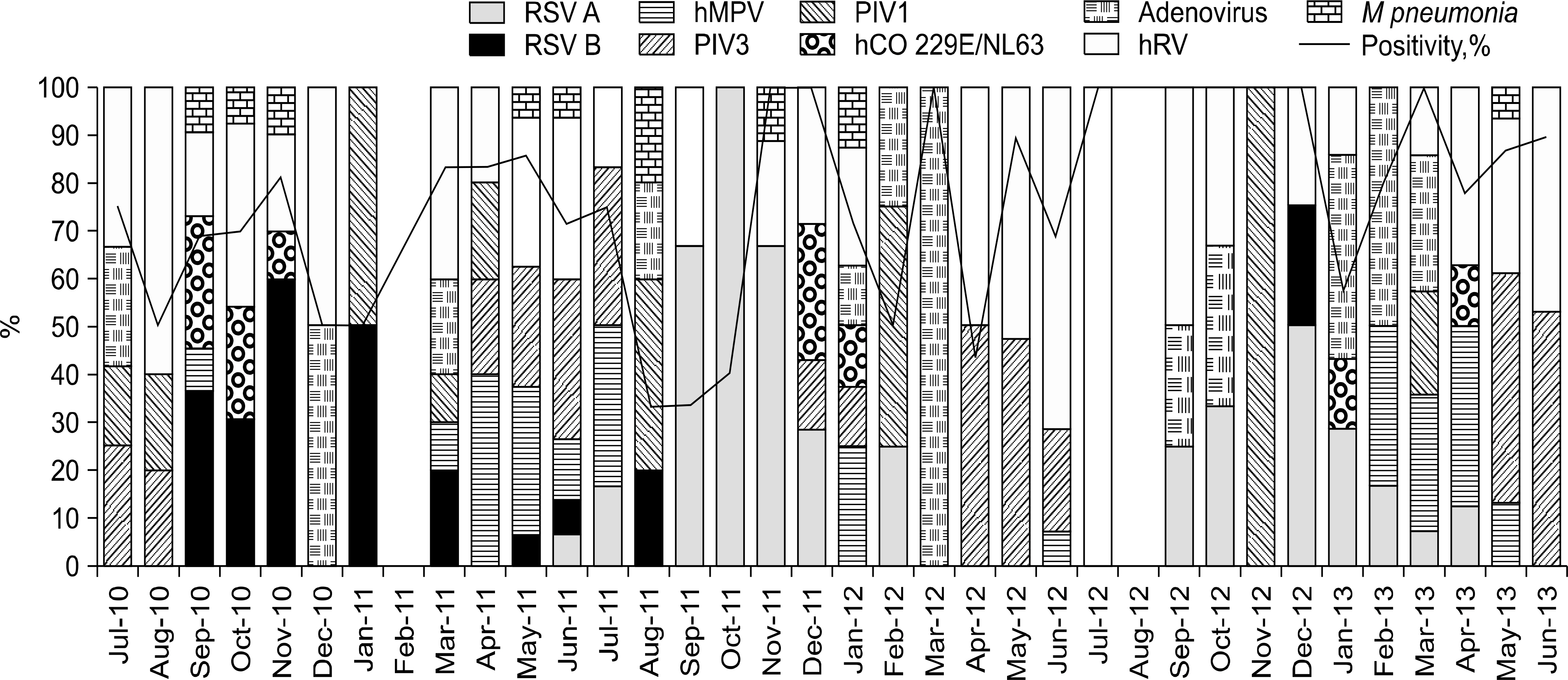Ann Clin Microbiol.
2014 Sep;17(3):86-90. 10.5145/ACM.2014.17.3.86.
Detection of Respiratory Viruses and Atypical Bacterial Pathogens in Infants with Acute Respiratory Infections Using Multiplex PCR
- Affiliations
-
- 1Department of Laboratory Medicine, Sanggye Paik Hospital, Inje University College of Medicine, Seoul, Korea. bmshin@unitel.co.kr
- KMID: 1971100
- DOI: http://doi.org/10.5145/ACM.2014.17.3.86
Abstract
- Multiplex PCR of nasopharyngeal aspirates detected viruses and atypical bacteria in 75.3% (219/291) of infants with acute respiratory infections from July 2010 to June 2013. Frequent viruses were human rhinovirus (29.9%), parainfluenza virus (21.7%), respiratory syncytial virus (17.9%), and human metapneumovirus (10.3%). Mycoplasma pneumoniae and Bordetella pertussis were detected in 3.4% and 0.3%, respectively.
Keyword
MeSH Terms
Figure
Reference
-
1.Johansson N., Kalin M., Tiveljung-Lindell A., Giske CG., Hedlund J. Etiology of community-acquired pneumonia: increased microb-iological yield with new diagnostic methods. Clin Infect Dis. 2010. 50:202–9.
Article2.Honkinen M., Lahti E., Österback R., Ruuskanen O., Waris M. Viruses and bacteria in sputum samples of children with community- acquired pneumonia. Clin Microbiol Infect. 2012. 18:300–7.3.Yoo SJ., Kuak EY., Shin BM. Detection of 12 respiratory viruses with two-set multiplex reverse transcriptase-PCR assay using a dual priming oligonucleotide system. Korean J Lab Med. 2007. 27:420–7.
Article4.Ham H., Jang J., Choi S., Oh S., Jo S., Choi S, et al. Epidemiological characterization of respiratory viruses detected from acute respiratory patients in Seoul. Ann Clin Microbiol. 2013. 16:188–95.
Article5.Kim JW., Seo HK., Yoo EG., Park SJ., Yoon SH., Jung HY, et al. Mycoplasma pneumoniae pneumonia in Korean children, from 1979 to 2006-a meta-analysis. Korean J Pediatr. 2009. 52:315–23.6.Song JH., Oh WS., Kang CI., Chung DR., Peck KR., Ko KS, et al. Asian Network for Surveillance of Resistant Pathogens Study Group. Epidemiology and clinical outcomes of community-acqu-ired pneumonia in adult patients in Asian countries: a prospective study by the Asian network for surveillance of resistant pathogens. Int J Antimicrob Agents. 2008. 31:107–14.7.Song JH., Thamlikitkul V., Hsueh PR. Clinical and economic burden of community-acquired pneumonia amongst adults in the Asia- Pacific region. Int J Antimicrob Agents. 2011. 38:108–17.8.Kim YN., Park CH., Kim SH., Yoo SJ., Kim HB. Factors associated with various clinical manifestations of Mycoplasma pneumonia in children. Allergy Asthma Respir Dis. 2013. 1:357–61.9.Choe YJ., Park YJ., Jung C., Bae GR., Lee DH. National pertussis surveillance in South Korea 1955-2011: epidemiological and clinical trends. Int J Infect Dis. 2012. 16:e850–4.
Article10.Kwon HJ., Yum SK., Choi UY., Lee SY., Kim JH., Kang JH. Infant pertussis and household transmission in Korea. J Korean Med Sci. 2012. 27:1547–51.
Article
- Full Text Links
- Actions
-
Cited
- CITED
-
- Close
- Share
- Similar articles
-
- Evaluation of Seeplex(TM) Pneumobacter Multiplex PCR Kit for the Detection of Respiratory Bacterial Pathogens in Pediatric Patients
- Comparison of R-mix Virus Culture and Multiplex Reverse Transcriptase-PCR for the Rapid Detection of Respiratory Viruses
- Chlamydia trachomatis respiratory infection in Korean young infants
- Risk Factors Associated with Respiratory Virus Detection in Infants Younger than 90 Days of Age
- Bacterial Upper Respiratory Infections


